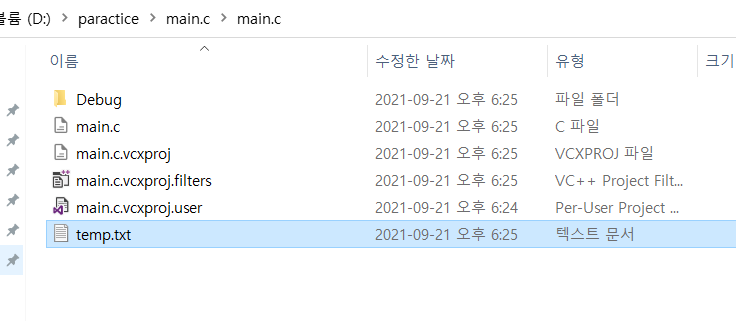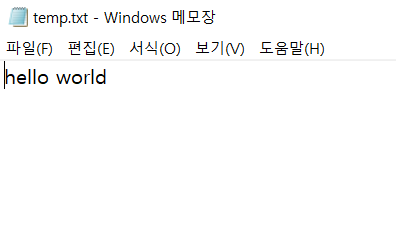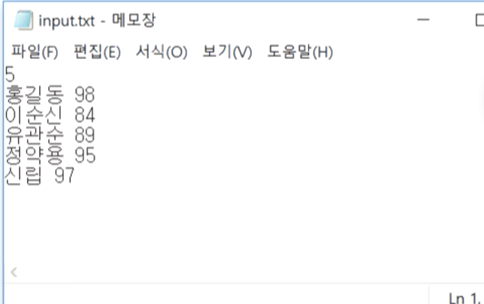17. 파일 입출력
17.1 필요성
프로그램이 꺼진 이후에도 데이터를 저장하기 위해 파일 입출력이 필요함.
17.2 파일 열고 닫기
파일 입출력 변수는 FILE형식의 포인트 변수로 선언한다.
파일을 열때는 fopen() 함수 사용
파일을 닫을때는 fclose() 함수 사용FILE *fp; fp = fopen(파일 경로, 접근 방식); fclose(fp);
17.3 fopen()
파일 경로와 접근 방식을 설정할 수 있다.
접근 방식
- r : 파일에 접근하여 데이터를 읽는다.
- w : 파일에 접근하여 데이터를 기록한다.(이미 존재하면 덮어쓰기)
- a : 파일에 접근하여 데이터를 뒤에서부터 기록
17.4 파일 입출력
fprint(파일 포인터, 서식, 형식지정자);
fscanf(파일 포인터, 서식, 형식지정자);
파일을 열 때에는 파일 포인터가 사용되며 이는 동적으로 할당된 것이다. 파일 처리 이후에 파일을 닫지 않으면 메모리 누수가 발생한다.
예제1
#define _CRT_SECURE_NO_WARNINGS
#include <stdio.h>
int main(void){
char s[20] = "hello world";
FILE *fp;
fp = fopen("temp.txt","w");
fprintf(fp,"%s\n",s);
fclose(fp);
return 0;
}
디버그를 하면 아래와 같은 창이 뜬다.

그리고 이 예제파일이 있는 위치로 가보면 temp.txt라는 파일이 생성되어있는 것을 알 수 있다.


위와 같이 우리가 fprintf에 쓴 내용이 입력되었다.
예제2 <학생 데이터를 읽어 그대로 출력하기>

위의 내용을 input.txt파일로 만든 후 진행한다.
#define _CRT_SECURE_NO_WARNINGS
#include <stdio.h>
#include <stdlib.h>//동적 메모리 할당하기 때문에 사용
#include <string.h>
typedef struct {
char name[20];
int score;
} Student;
int main(void){
int n, sum=0;
FILE *fp;
fp = fopen("input.txt","r");
fscanf(fp,"%d",,&n);
Student *students = (Student*)malloc(sizeof(Student)*n);
for(int i=0; i < n; i++){
fscanf(fp, "%s %d" , &((students +i)->name), &((students + i)->score));
printf("이름: %s, 성적: %d\n",(students +i)->name,(studnets+i)->score);
}
system("pause");
return 0;
}실행하면
예제3 <성적 평균 구하고 메모리 할당 해제하기>
#define _CRT_SECURE_NO_WARNINGS
#include <stdio.h>
#include <stdlib.h>
typedef struct{
char name[20]'
int score;
}Student;
int main (void){
int n,sum=0;
FILE *fp;
fp = fopen("input.txt","r");
fscanf(fp,"%d", &n);
Student *students = (Student*)malloc(sizeof(Student) *n);
for(int i=0; i<n;i++){
fscanf(fp,"%s %d",&((studnets +i)->name),&((students + i)->score));
}
for(int i=0; i<n;i++){
sum += (studnets +i)->score;
}
free(students);
fclose(fp);
printf("점수 평군: %.2f\n", (double)sum /n);
system("pause");
return 0;
}
